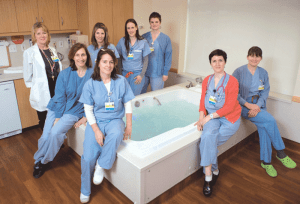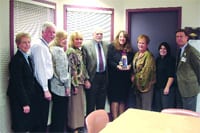CDH’s Hydrotherapy Tub Provides Comfort for Laboring Moms
NORTHAMPTON — If Gabriel Kennedy Costa’s newborn son had been born closer to his due date, Costa wouldn’t have been able to experience the soothing benefits of warm-water immersion in Cooley Dickinson Hospital’s new hydrotherapy tub.
“It was a race to the finish,” said Costa of the timing of when the tub would be ready and when she would deliver. On March 25, Theodore Dennis Ehnstrom made his arrival 10 days later than Costa’s original due date of March 15. But it was just in time for Costa to be the first mom to labor in the Childbirth Center’s new tub.
Costa, who had experienced contractions “for a long time” at her Amherst home, said the tub provided a nice interlude. “The weightlessness of the water let me float. It is such a large tub that I could really stretch out. It was a sensation I had never experienced.”
Cooley Dickinson Hospital’s Childbirth Center recently received approval from the state Department of Public Health (DPH) to offer hydrotherapy (warm-water immersion) to women during labor as a method of relaxation, comfort, and pain management.
“I have often observed the soothing, calming effects of hydrotherapy on laboring moms,” said Annie Heath, a certified nurse midwife. “Studies show that women in labor who use the tub experience less pain and anxiety, too. I am pleased we can offer hydrotherapy for women in labor who seek this option as part of their birth plans.”
Heath describes the room that houses the tub as spacious and calming. The tub itself is a permanent, one-person tub equipped with massaging jets that help to relieve contractions and back pain prior to labor. Other physiological and psychological benefits of hydrotherapy include ease of movement with greater mobility due to the buoyancy of the water, relaxation during contractions, safe and effective pain management, and a sense of control in a warm environment leading up to the delivery of a baby.
Now that the DPH has approved the hydrotherapy plan and accepted Cooley Dickinson’s policy regarding the practice, Chief Medical Officer Dr. Mark Novotny noted, women for whom an uncomplicated vaginal birth is anticipated and who do not have medical conditions that could pose a risk may choose hydrotherapy while they are laboring. A woman’s physician or certified nurse midwife is required to approve use of the tub, and patients need to sign a hydrotherapy consent form (a Massachusetts requirement).
Dr. Tucker Kueny, chair of the Department of Obstetrics, said that, while research supports the benefits of hydrotherapy during labor, medical experts do not agree that the benefits of delivery in water outweigh the potential risks to the mother and baby. Given this lack of agreement, Cooley Dickinson’s tub will not be used to deliver babies.
However, a March 2014 committee opinion report from the American College of Obstetricians and Gynecologists and the American Academy of Pediatrics acknowledged that decreased pain, reduced use of anesthesia, and shorter labors may be positive effects of water immersion during active stages of labor. Women who are medically appropriate to use the tub have access on a first-come, first-served basis.
To ensure that women who seek hydrotherapy will labor in water safely, Cooley Dickinson’s perinatal safety committee approved a new policy regarding hydrotherapy in labor that stipulates criteria for tub use. The policy sets protocols in accordance with guidelines from the committee Oopinion report issued by the ob/gyn and pediatrics groups.
For example, women with pre-eclampsia or a suspected infection may not choose hydrotherapy, Kueny said. Other safety protocols include a mechanical lift above the tub so that staff can safely move a woman to a nearby bed who has trouble getting out of the tub or who needs to be moved quickly, as well as a training program on the new policy and procedures for midwives, nurses, and physicians.





Comments are closed.